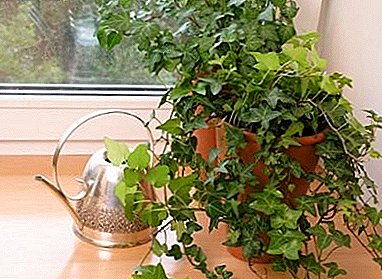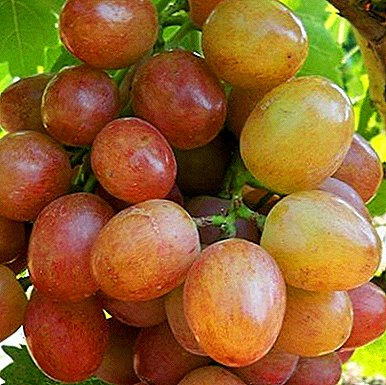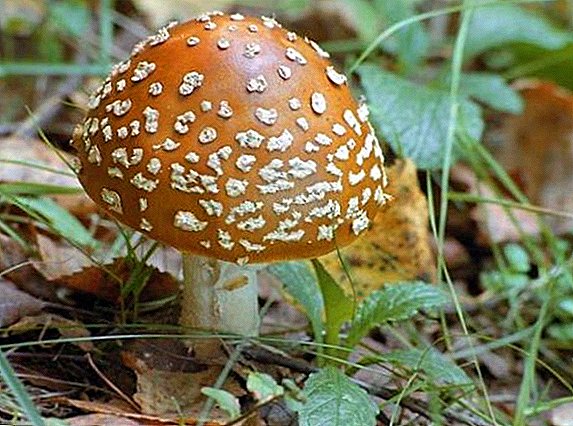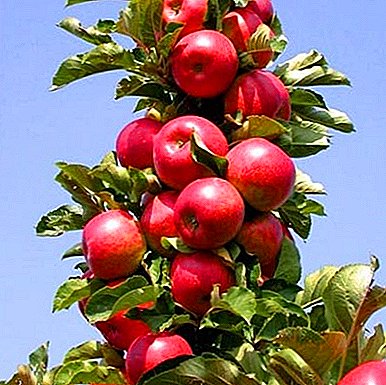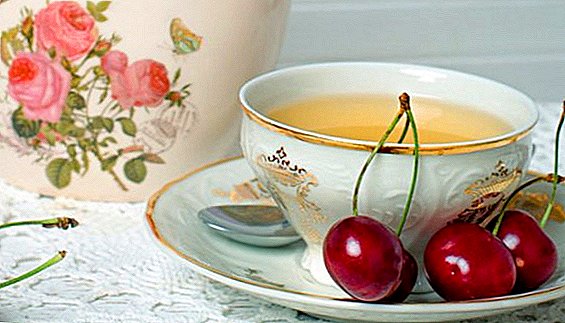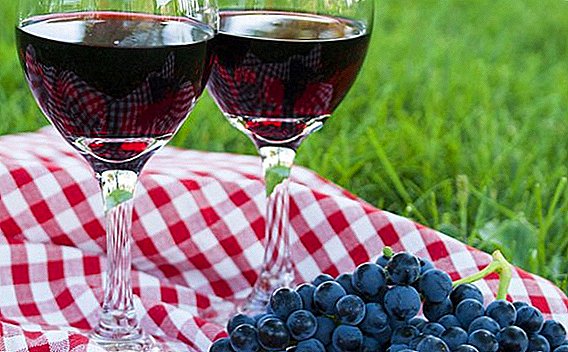 For many of us, the usual pattern is the presence of Isabella grapevine on the backyard. You would think that the only virtues of this berry are its unpretentiousness and resistance to frost, which is important for our latitudes. However, this is not the case. Grapes "Isabella", in addition to these qualities, has many other useful properties.
For many of us, the usual pattern is the presence of Isabella grapevine on the backyard. You would think that the only virtues of this berry are its unpretentiousness and resistance to frost, which is important for our latitudes. However, this is not the case. Grapes "Isabella", in addition to these qualities, has many other useful properties.
Brief description of the variety
The homeland of the Isabella grape variety is the United States, where in the 19th century, by crossing European cultivated grapes and wild American, a natural interspecific hybrid appeared.
Did you know? The name of the grape variety "Isabella" was in honor of the mistress of the land, where the variety was bred - Isabella Gibbs.
Unculpable variety, harvest rather late, from late September to November. Berry grows well and bears fruit in Moldova, Belarus, Ukraine, the central part of Russia, in Siberia and on the Volga, in the humid regions of the Caucasus.  Variety enough fertile and frost resistant (up to -30 ° C). Clusters have a conical shape. They can be either medium in size (weighing up to 0.25 kg) or quite large (more than 2.3 kg).
Variety enough fertile and frost resistant (up to -30 ° C). Clusters have a conical shape. They can be either medium in size (weighing up to 0.25 kg) or quite large (more than 2.3 kg).
The berries are sweet, of medium size, dark blue, almost black. Berry weight - up to 3 g, in diameter can reach 18 mm. The dense skin is quite easily separated from the fetus. The pulp has a rich smell with hints of strawberry and raspberry.
Sugar content - 15.4 Brix, acidity - 8
The berries have a high content of iron, iodine, vitamins A and B.
Learn more about the beneficial properties and characteristics of the use of grapes.
Grape composition
The composition of grapes "Isabella" high content amino acidsinvolved in endocrine processes and necessary for the production of proteins by our body:
- arginine is involved in the synthesis of urea;
- lysine is necessary for the growth of the body;
- valine is involved in neuroregulation;
- leucine is responsible for protein synthesis;
- phenylalanine - the synthesis of hormones and blood formation processes;
- methionine - body development, carotene synthesis, fat absorption and fat balance regulation, liver protection;
- Isoleucine is required for normal synthesis of other amino acids.

Micro and macro elements
Of macronutrients in the berries most of all potassium, about 250 mg. Then, in descending order: calcium, sodium, phosphorus, magnesium.
Also present in the composition (the content of each element is less than 10 mg): sulfur, chlorine, iron, aluminum, zinc, molybdenum, copper.
Important! The yield of grapes "Isabella" reaches 7 tons per hectare of usable area.
Vitamins
Vitamins contained in the berry in such quantities:
- A - 0.15 mg;
- B1 - 45 µg;
- B2 - 25 mcg;
- PP - 0.27 mg;
- B5 - 95 µg;
- B6 - 620 mg;
- B9 - 3.0 µg;
- C, 5.5 mg;
- E — 0.35 mg;
- Biotin - 3 µg;
- K - 0.6-2.2 mcg.

BJU
100 g of grapes contains:
- water - 80.5 g;
- protein - 0.6 g;
- fat - 0.6 g;
- carbohydrates - 15.5 g;
- fiber - 1.5 g;
- pectins - 0.5 g;
- Organic acids - 0.85 g;
- ash residue - 0.5 g
Calorie berries
Calorie content - about 80 kcal per 100 g
Did you know? There is an opinion that fermentation was initially only a way to preserve juice, and ethanol intoxication was only an integral by-product.
What is the use of varieties
In addition to the berries, the main crop of the vine, other products of valuable culture were used. For example, the leaves are used to make famous Caucasian dishes - dolma, although this is not their only use. 
Berries
Isabella is a dark variety. Its color indicates a high content of anthocyanins - substances that protect our body from bacteria and free radicals. Berries have positive action of this nature:
- increase the elasticity of the walls of blood vessels;
- beneficial effects on hemoglobin levels;
- normalize blood pressure;
- deducing decay products from the body;
- normalize heart function.
The highest content of antioxidants - in the seeds and peel. Flavonoids contribute to the elimination of nitrates and toxic metal salts. Juice is an excellent tool for recuperation - it is recommended for people experiencing severe physical exertion during post-operative and post-morbid rehabilitation, as well as for people with psychological problems (depression).
Important! In Europe and America, the Isabella variety is prohibited for commercial cultivation and for making wine from it. The official reason is the high content of methanol in wine. Later this statement was not confirmed by research. There is an opinion that the producers of more expensive grape varieties and wines from it were lobbying their own interests with such informational stuffing.
Leaves and Stems
Not only berries, but also leaves of the plant have useful properties:
- freshly picked leaves placed on different parts of the body can reduce the temperature;
- infusion of leaves taken when coughing, it has expectorant and analgesic action;
- With a decoction of the leaves, acute tonsillitis and pharyngitis are treated, and a fresh leaf helps to heal wounds.
 In folk medicine, apricot is used - the juice of the vine. Collect juice in April - at this time nature awakens, and accordingly, the product obtained from the vine grapes, has the property to give vitality to our body. The high content of vitamins and organic acids has found its application in the treatment of gout, hemorrhoids, seizures, it also improves the digestive tract.
In folk medicine, apricot is used - the juice of the vine. Collect juice in April - at this time nature awakens, and accordingly, the product obtained from the vine grapes, has the property to give vitality to our body. The high content of vitamins and organic acids has found its application in the treatment of gout, hemorrhoids, seizures, it also improves the digestive tract.Check out the recipe for making homemade champagne from grape leaves.
Possible harm
- Weight gain. "Isabella" is rich in sugar, so if you lose weight, you should not eat more than 50 grams of berries a day. You should also consider the sugar content in other products.
- Hypertension. Due to the high potassium content in the berries, thirst can occur. A large amount of water consumed promotes pressure.
- Increased acidity of gastric juice.
- Diarrhea.
Explicit contraindications
- Allergic reaction of the body.
- Diabetes.
Important! Carbolic acid, which is a means of combating cancer, is contained in the skin of red grapes.
How to make wine from grapes: a step by step recipe with photos
Wine is the most famous and ancient use of the berry. The remains of the product are still found in ancient amphorae at the bottom of the Mediterranean Sea. Let's try and we make a delicious, natural and healthy homemade wine.
What is needed
For making wine we need:
- grapes;
- glass bottle (25 l);
- sugar (optional);
- tight lid with water seal;
- siphon (hose with a tube);
- household refractometer;
- glass packaging for finished wine.
Step-by-step recipe
- Gather grapes should be in dry weather, so that natural yeast is on the surface.
- The harvest should be separated from the branches, leaving some berries.
- You can make wine from the same variety, and you can experiment by mixing Isabella, for example, with Lydia.
- We crush the berry with our hands, send the resulting mass (pulp) to an enameled pan.
- Using a household refractometer, we check the sugar level in the juice (a normal figure for Isabella is 20-22%).
- Cover the pot with the contents with gauze and a lid, put in a dark place to start the fermentation process, stir the pulp every day.
- After 6 days, using a colander and gauze, we separate the pulp from the juice that started to ferment.
- Pour the filtered juice into a prepared glass bottle (thoroughly washed with cold water and sterilized).
- Again, take a test for sugar. There are special tables matching the level of sugar to the alcohol content in the finished product (for example, 17% of the sugar in the juice will yield about 10% alcohol).
- Throwing husks is not worth it, you can make chacha from them.
- We put the bottle of juice under the water seal, leave it in a dark place at room temperature.
- After 10 days (by this time the wine will cease to play actively), it is necessary to clarify the juice, drain it for the first time from the sediment. With the help of a siphon (a hose with a tube, calculated on the length so that when lowering it into the bottle, it does not reach the sediment) carefully, so as not to catch the sediment, pour out the wine.
- If desired, we can add sugar (at the rate of 50-60 g per liter). In this case, the juice should be slightly heated, for better dissolution.
- We pour the clarified juice back into a clean bottle and place it under the water seal (recommended air temperature is 19-21 ° C), this is a period of quiet fermentation.
- After a month of quiet fermentation, it is necessary to drain the wine from the second sediment. We do it the same way as the first time.
- About 10 days later, for the third time, pour out the wine from the sediment.
- Now we will lighten the wine with bentonite. We take bentonite (3 tablespoons per 20 liters), soak it in a small amount of water until the consistency of sour cream. Fill the wine and bentonite in the bottle and thoroughly mix it 3-4 times a day, leaving it to full clarification.
- About a week later, with the help of a siphon, we pour the wine into clean sterilized cans and bottles, put it in the cold (cellar).
















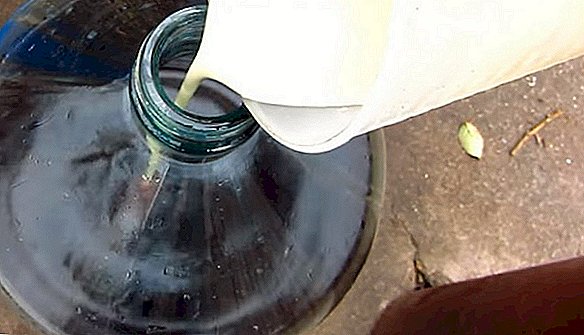

Read also about cooking wine from plums, black currants, raspberries, rose petals, apples, compote.
How to make a compote of "Isabella": a recipe at home
If you think that making wine is a laborious process and you can’t do it or for some other reason you don’t want to make it, try making another drink - a delicious compote of grapes and apples.
Ingredient list
For homemade compote, we need:
- grapes (berries) - 0.5 kg;
- apples - 2 pcs .;
- sugar - 300-350 g;
- a pinch of citric acid;
- water.
Recipe
- The washed berries and sliced and cut apples from the core are put into the prepared bottle (you can add, for example, a little strawberry), add sugar to the same place.
- Fill the bottle of fruit to the top with water.
- We put in a large pot of boiling water for sterilization, after boiling we sterilize for 30 minutes.
- We take out the bottle, add a pinch of acid, add boiling water to the top and roll it up with a tin lid.
- Well close the compote with a blanket and leave for a day, until it cools completely.




See also recipes for making compote made from cherries, apricots, plums, apples, pears, dogwoods, currants, strawberries, blueberries, cranberries, and melons.
More about the benefits of grapes
A few words about the benefits of juice and other products from the sunny berries.
The benefits of grape juice
Sugar in the juice is in a form that is easily absorbed by the body - fructose and glucose. These carbohydrates are directly involved in energy exchange. Minerals and vitamins that are abundantly contained in juice can compete with vitamin complexes of industrial production. Water makes up 80% of the volume of juice, so it is an excellent tool for maintaining the body's water balance.
Learn more about the benefits of grape juice and seed.
How are grape seeds useful?
Bone grapes in its composition richer than the flesh. It has everything that is present in the pulp, but in large quantities. Especially a lot of vitamins E and B, proteins. The oil contained in the bone promotes wound regeneration and improves eyesight. Phytohormone is especially useful for the female body. It has a positive effect on the work of the heart muscle, proved to be effective in Parkinson's and Alzheimer's disease.
Did you know? The Bible states that grape juice, along with fire, clothing, iron, water, milk, and wheat flour, is one of the basic needs for human life (Sirah 39:32).
Useful properties of vinegar
- Effective in disorders of the digestive tract, to improve the endocrine processes of the body, normalizes the acidity of the stomach.
- Fills the deficit of potassium, increases stamina, relieves fatigue.
- A beneficial effect on the condition of the skin, hair and nails.
- Effective in removing corns, corns and other dermatological problems.
- It has long been known as a treatment for gout and salt deposits.
- Gargles relieve nasopharyngeal inflammations.
 Now on the market are many exotic grape varieties, previously unknown to us. They have wonderful appearance and great taste. But still, for many of us, Isabella grapes remain practically native, “local” variety. It does not just grow on most household plots, having gained popularity due to unpretentiousness and frost resistance, this berry is a real storehouse of vitamins and minerals, which are so necessary for us in the conditions of modern life.
Now on the market are many exotic grape varieties, previously unknown to us. They have wonderful appearance and great taste. But still, for many of us, Isabella grapes remain practically native, “local” variety. It does not just grow on most household plots, having gained popularity due to unpretentiousness and frost resistance, this berry is a real storehouse of vitamins and minerals, which are so necessary for us in the conditions of modern life.

